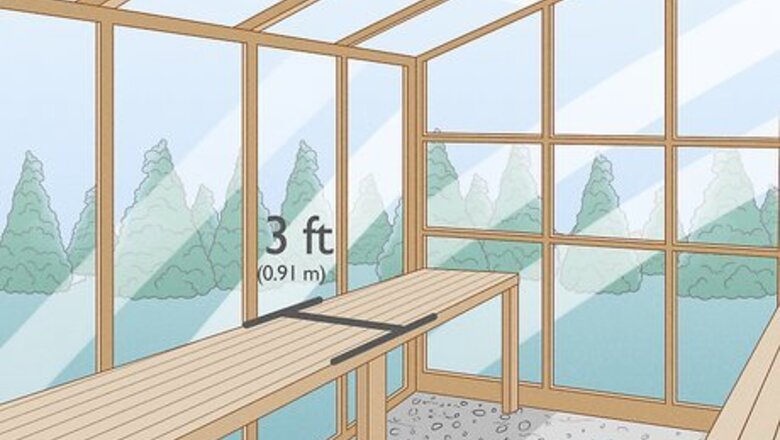
views
Row Layout

Set up benches that are less than 3 ft (0.91 m) wide along the walls. If your benches are too wide, you won’t be able to reach the part of the bench that’s furthest from you. Line the sides of your greenhouse with your long benches if you’re using them. If you’re just keeping plants on the ground, don’t make your row of plants more than 3 feet (0.91 m) deep. You don’t have to use rows if you don’t want to, but it’s basically the universal layout for a greenhouse. People typically place 1 row of benches or plants along each of the longer walls, and a third row of plants or benches in the middle if there’s space. A greenhouse “bench” is really just a table. Growing benches come in all types of sizes and materials, but you can honestly just repurpose old tables if you prefer. There isn’t a huge difference. Just stay away from wood, which can rot over time if it gets wet. It’s okay to use thinner rows or benches if you have a smaller greenhouse.

Leave at least 19 inches (48 cm) between rows to make walkways. As you’re arranging your greenhouse, keep in mind that you need room to move around. Always leave at least 19 inches (48 cm) of space between rows of furniture and/or plants to leave a comfortable path. If you tend to lug a lot of equipment or pots around, leave at least 24 inches (61 cm) of space between rows. If you aren’t using rows, it may take you a bit longer to move from one end of the greenhouse to the other. If you’re okay with that, go for it!
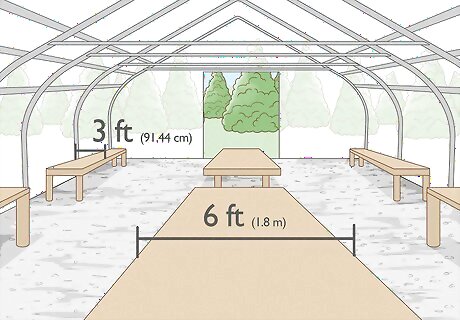
Put bigger benches in the middle of the greenhouse if you have the space. If you’re putting bigger benches in your greenhouse, line them along the center of the greenhouse. Don’t use anything wider than 6 feet (1.8 m), though. This way, you can reach the middle of the table from either side of the greenhouse depending on where you’re standing. If you’re not using benches and your plants are on/in the ground, the same premise applies. Don’t plant a row of vegetables that’s 7 ft (2.1 m) wide, for example. You’ll never be able to reach the middle.
Work and Grow Zones

Place the potting bench on a wall near your plumbing source or door. The easiest way to layout a greenhouse is to designate separate zones for different types of work and plant growing. Start with your potting bench. This is where you’ll repot plants, mix fertilizer, and do prep work. Place your bench against the sink or water line if you have one. If you don’t, keep it near the door where the temperature will be less stable. Designating zones is the easiest way to group similar items and plants together. Since cuttings, seedlings, mature plants, and different species require different levels of heat and light, you can arrange your zones in a way where every plant benefits while making your workflow easier. Potting benches often have shelves and drawers, but you can use anything as a potting bench. If part of your greenhouse is shaded and you can’t use it for much outside of storage, you can place your potting bench there.
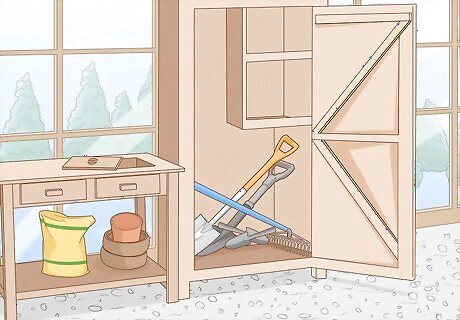
Set a section aside for storing tools and supplies near the bench. Whether you keep your tools on a shelf, in a cooler, or on a table, you want easy access to them from your potting bench. Store your cutting tools, trowel, and gloves all in one location. Set a secondary storage section aside to warehouse soils, fertilizers, nutrients, and insecticides. Keep all of your supplies in one place if you want to keep things simple. Your watering cans, soils, and fertilizers will all be easier to find if they’re only in one area of the greenhouse. Many gardeners develop their own storage system independently, but the easiest way to stay organized is to use stackable plastic containers. Get clear containers if you can so you can look inside, and label the outside of each container.
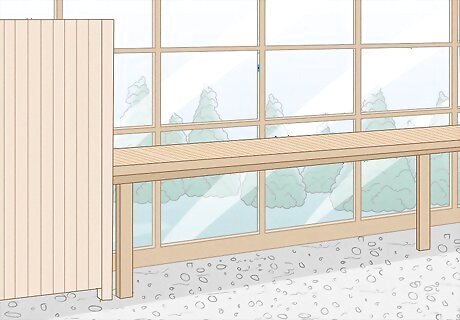
Choose a dedicated bench to propagate your plants. If you take cuttings or grow seedlings, you’re going to end up with shards of wood and layers of soil dust everywhere. Choose one bench to do your propagation work to avoid making a mess around your mature plants. This is also a good idea if you use propagation mats to heat and grow plants when it’s cold out. If you have a smaller greenhouse, you can use your potting bench for this. It may be nice to have a dedicated space for growing cuttings and seedlings, though!
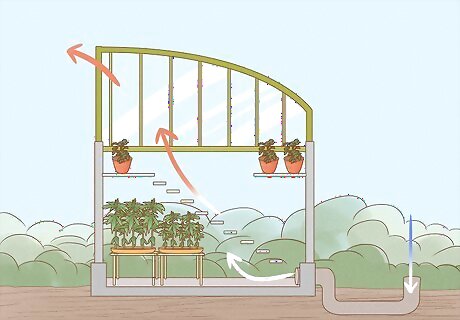
Create hot and cold zones if you have a heat source. If you use a heater to keep your greenhouse warm in the winter but some of your plants require a yearly cool period, set the heater on one side of your greenhouse. This way, you can maintain a hot and cold zone. When fall is transitioning into winter, rearrange your potted plants so the plants that require higher temperatures are closer to the heater. You don’t have to heat your greenhouse, especially if you’re growing perennials that require a cooling period or you live in a hotter climate.
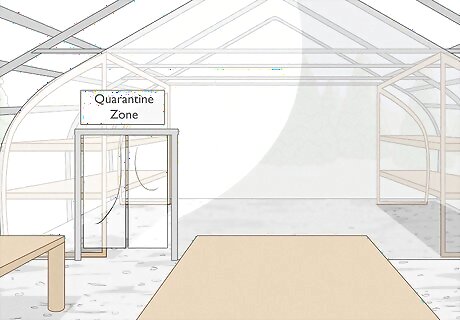
Designate a quarantine zone in a closed-off area if you add plants often. If your greenhouse has an enclosed entryway, use it as the quarantine zone for new plants. This way, you won’t spread potential pests to the other plants in your greenhouse. This will also be helpful if any of your plants show signs of disease since you can separate them from the others while you diagnose and handle the issue. If you don’t have a separate space, consider building a miniature greenhouse inside or next to your main structure to make quarantining plants easy.
Plant Arrangements
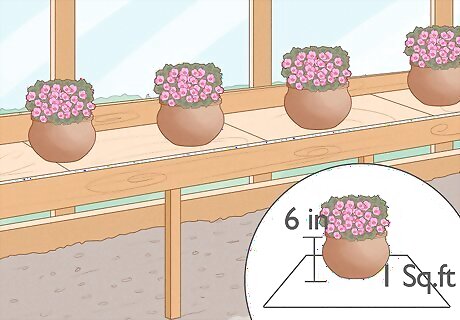
Set aside 1 sq ft (930 cm) for each 6 in (15 cm) pot. This way, each plant will have plenty of access to light and they won’t be crowded out by shade from surrounding plants. This will also make it easier to reach down and pick a pot up without knocking everything over. Obviously, if your plants are in trays or on the ground the space you leave between each plant will depend on whatever you’re growing. Potatoes, orchids, and rosemary all have different space requirements.
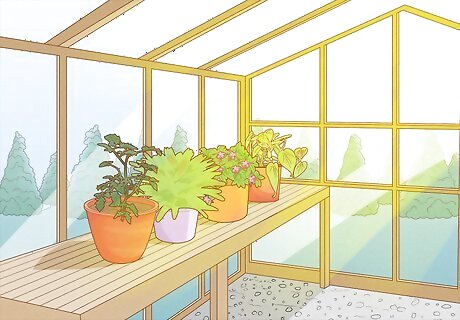
Place plants with high light requirements along the sunniest side of the greenhouse. Depending on the orientation of your greenhouse, one side of the greenhouse is likely sunnier than the other. Set up benches along that wall or leave the floor along that wall open to house your sun-hungry plants. If both sides get equally sunny, just choose a dedicated wall for these plants. You don’t have to use benches if you don’t want to, but they’re a good idea if you want to maximize space since you can store equipment underneath. It’s totally okay to leave your plants on/in the ground, though.
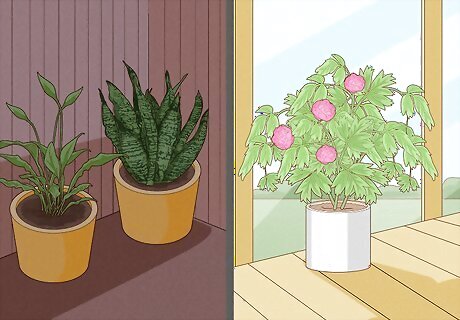
Set hardier and light-sensitive varieties along the darkest wall. If you’re growing anything that requires a few hours of indirect light, place those plants together along the darker portion of the greenhouse. This is also an ideal location for hardier plants, like Queen Anne’s lace or peonies, that won’t be in much trouble if they don’t get the perfect amount of water or light. You can also set these plants in the cold zone if you’re using a heat source in your greenhouse. Many drought-resistant plants and perennials will hold up just fine in a cold zone.
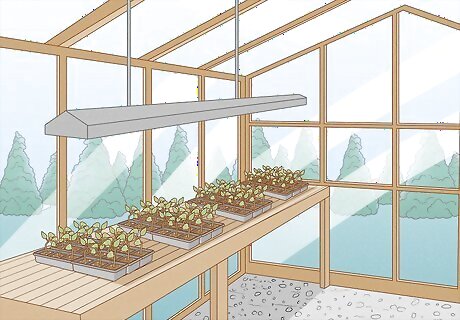
Put seedlings in the warm zone on a higher bench or shelf. Heat rises, and seed trays often take up a fair bit of space. Rows of high-level shelving are perfect for seed trays if you grow a lot of plants from seed, since they tend to require lots of sunlight and heat. Set your seed trays together on a high bench or set of shelves to keep them healthy and out of the way while you’re waiting for your seedlings to mature. Don’t set your seedlings so high that you’re going to forget about them. It’s also a good idea to keep the shelving around eye level, since you can visually inspect the seedlings while you’re watering or misting them.
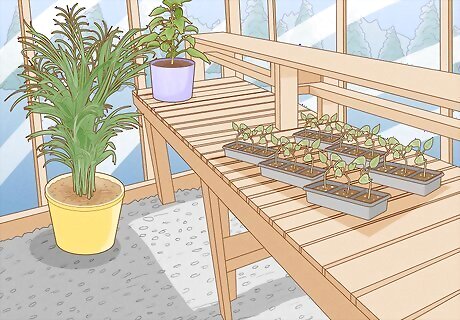
Place taller plants on floor beds or shorter benches. If you’re growing any plants that grow especially tall, like tomatoes or aubergines, set them closer to the floor so that they have plenty of space above them. Don’t hang any plants from that portion of the greenhouse and don’t set any shelving behind the plants so that they have plenty of room to flourish. You can use a trellis to prop up vines and give them something to hang on to if you’d like.

Reserve an open space for over-wintering outdoor plants. If you bring plants from your porch into your greenhouse for the winter, leave a dedicated space for them on a bench or portion of your floor. This will also keep you from over-packing your greenhouse and give you an area to temporarily place things if you do any rearranging in the future.
Space-Saving Tricks
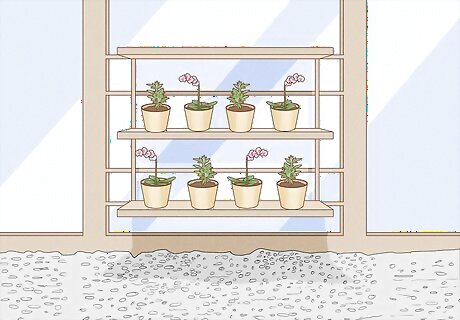
Take advantage of vertical space by placing shelving behind benches. Stacking freestanding shelves behind unoccupied benches may cut back on how much sun each plant gets, but you can always set plants that only need indirect light in front of the shelves. This is a great option if you tend to lose track of which fertilizer belongs with which plant, too, since you can designate each shelf as a row of plants. You can purchase benches with built-in shelving if you want to keep things simple!
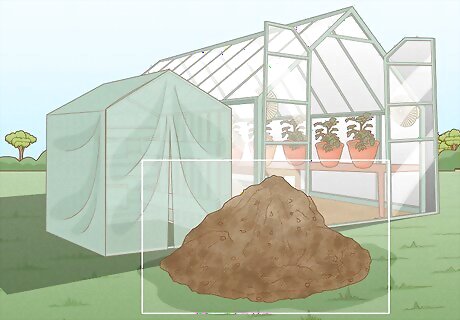
Move your compost pile outside to free up space. If you use compost to fertilize your plants or provide groundcover, keep it outside. This is one of the easiest ways to free up room, since compost develops just fine outside. Lining the edges of your greenhouse with the compost will also help insulate the greenhouse if you notice a draft in the wintertime. The same goes for gravel. If you use gravel to cover the ground or insulate plants, store it outside. It won’t go bad out there and it’s unlikely you’re using it all that often.

Use benches with wheels on them to make rearranging easier. Instead of using regular tables or stationary benches in your greenhouse, get benches with wheels on them. Even if your greenhouse doesn’t have a paved floor, it will still be easier to move your benches around if they have wheels on them. You can always install caster wheels on the benches you already have. Just purchase sets of caster wheels at your local construction supply store and glue or drill them into the feet of each bench.















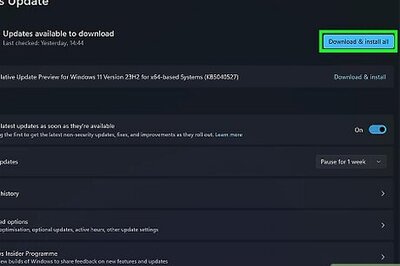



Comments
0 comment